height adjustment MAZDA MODEL CX-9 2020 Owners Manual (in English)
[x] Cancel search | Manufacturer: MAZDA, Model Year: 2020, Model line: MODEL CX-9, Model: MAZDA MODEL CX-9 2020Pages: 706
Page 17 of 706
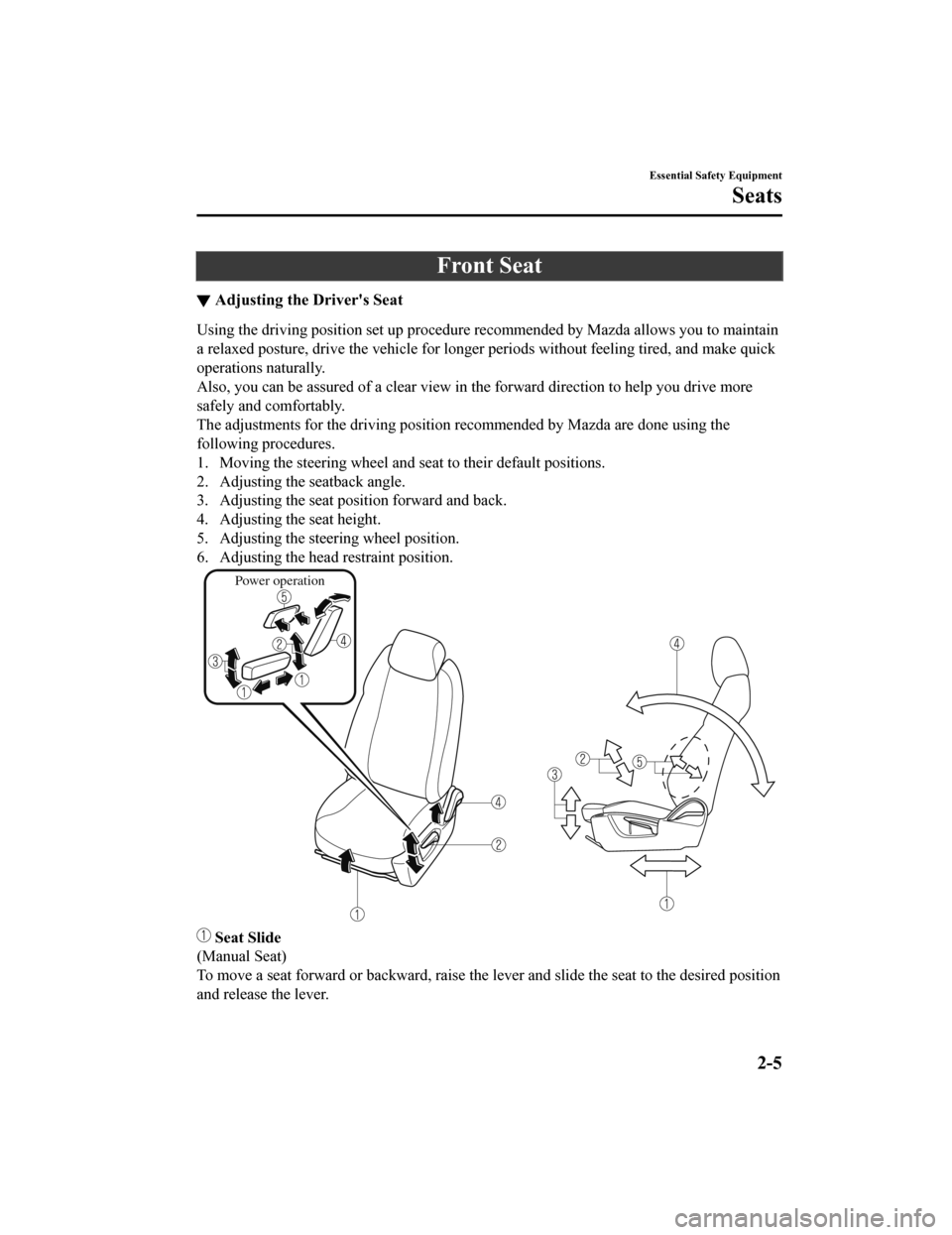
Front Seat
▼Adjusting the Driver's Seat
Using the driving position set up procedure recommended by Mazda allows you to maintain
a relaxed posture, drive the vehicle for longer periods without feeling tired, and make quick
operations naturally.
Also, you can be assured of a clear view in the forward direction to help you drive more
safely and comfortably.
The adjustments for the driving position recommended by Mazda are done using the
following procedures.
1. Moving the steering wheel and s
eat to their default positions.
2. Adjusting the seatback angle.
3. Adjusting the seat position forward and back.
4. Adjusting the seat height.
5. Adjusting the steering wheel position.
6. Adjusting the head restraint position.
Power operation
Seat Slide
(Manual Seat)
To move a seat forward or backward, raise the lever and slide the seat to the desired position
and release the lever.
Essential Safety Equipment
Seats
2-5
CX-9_8HT8-EA-19I_Edition2_old 2019-9-24 13:14:55
Page 18 of 706
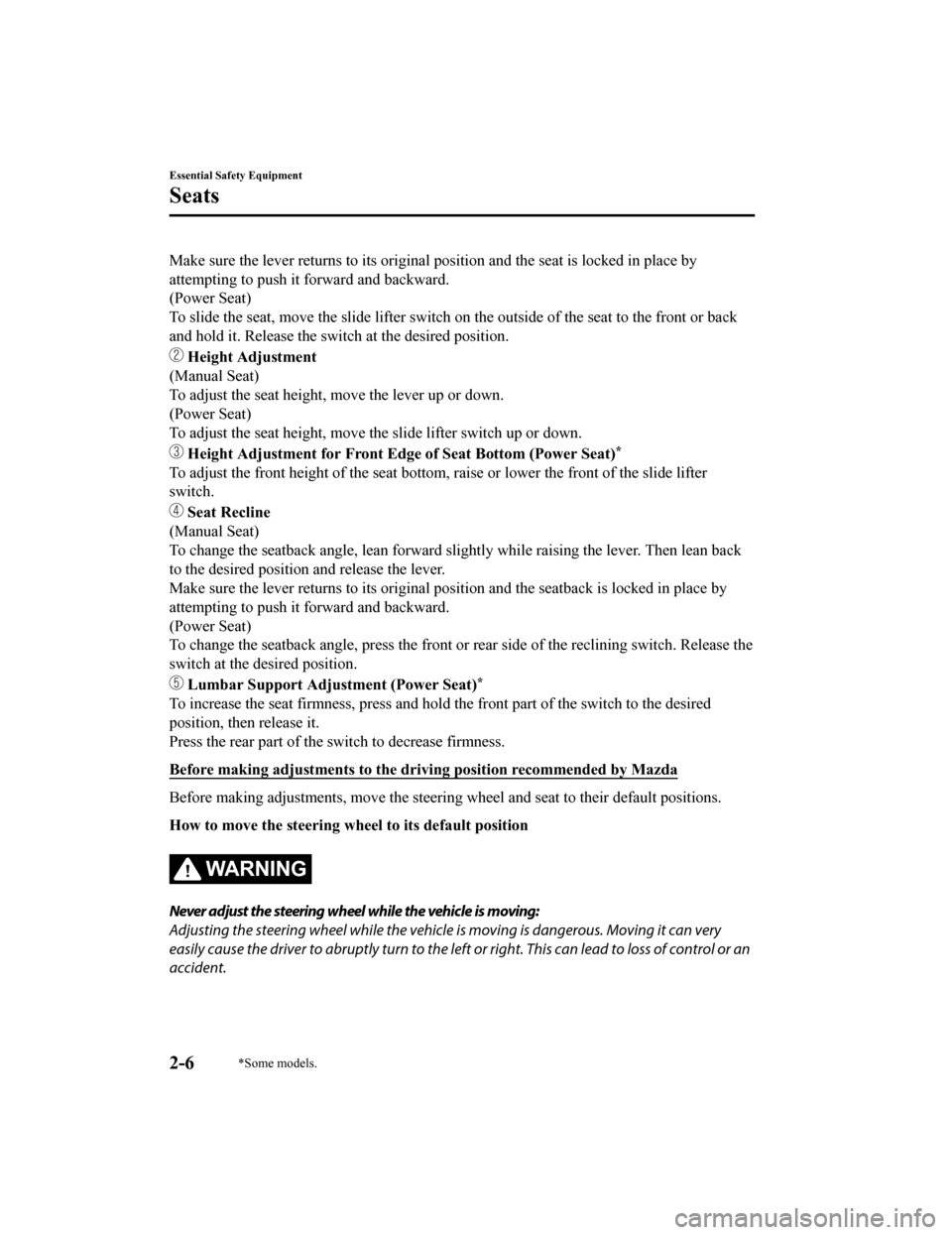
Make sure the lever returns to its original position and the seat is locked in place by
attempting to push it forward and backward.
(Power Seat)
To slide the seat, move the slide lifter switch on the outside of the seat to the front or back
and hold it. Release the switch at the desired position.
Height Adjustment
(Manual Seat)
To adjust the seat height, move the lever up or down.
(Power Seat)
To adjust the seat height, move the slide lifter switch up or down.
Height Adjustment for Front Edge of Seat Bottom (Power Seat)*
To adjust the front hei ght of the seat bottom, raise or lower the front of the slide lifter
switch.
Seat Recline
(Manual Seat)
To change the seatback angle, lean forward sl ightly while raising the lever. Then lean back
to the desired position and release the lever.
Make sure the lever returns to its original po sition and the seatback is locked in place by
attempting to push it forward and backward.
(Power Seat)
To change the seatback angle, press the front or rear side of the reclining switch. Release the
switch at the desired position.
Lumbar Support Adju stment (Power Seat)*
To increase the seat firmness, press and hold the front part of the switch to the desired
position, then release it.
Press the rear part of the switch to decrease firmness.
Before making adjustments to the driving position recommended by Mazda
Before making adjustments, move the steerin g wheel and seat to their default positions.
How to move the steering wheel to its default position
WA R N I N G
Never adjust the steering wheel while the vehicle is moving:
Adjusting the steering wheel while the vehicle is moving is dangerous. Moving it can very
easily cause the driver to abruptly turn to the left or right. This can lead to loss of control or an
accident.
Essential Safety Equipment
Seats
2-6*Some models.
CX-9_8HT8-EA-19I_Edition2_old 2019-9-24 13:14:55
Page 19 of 706
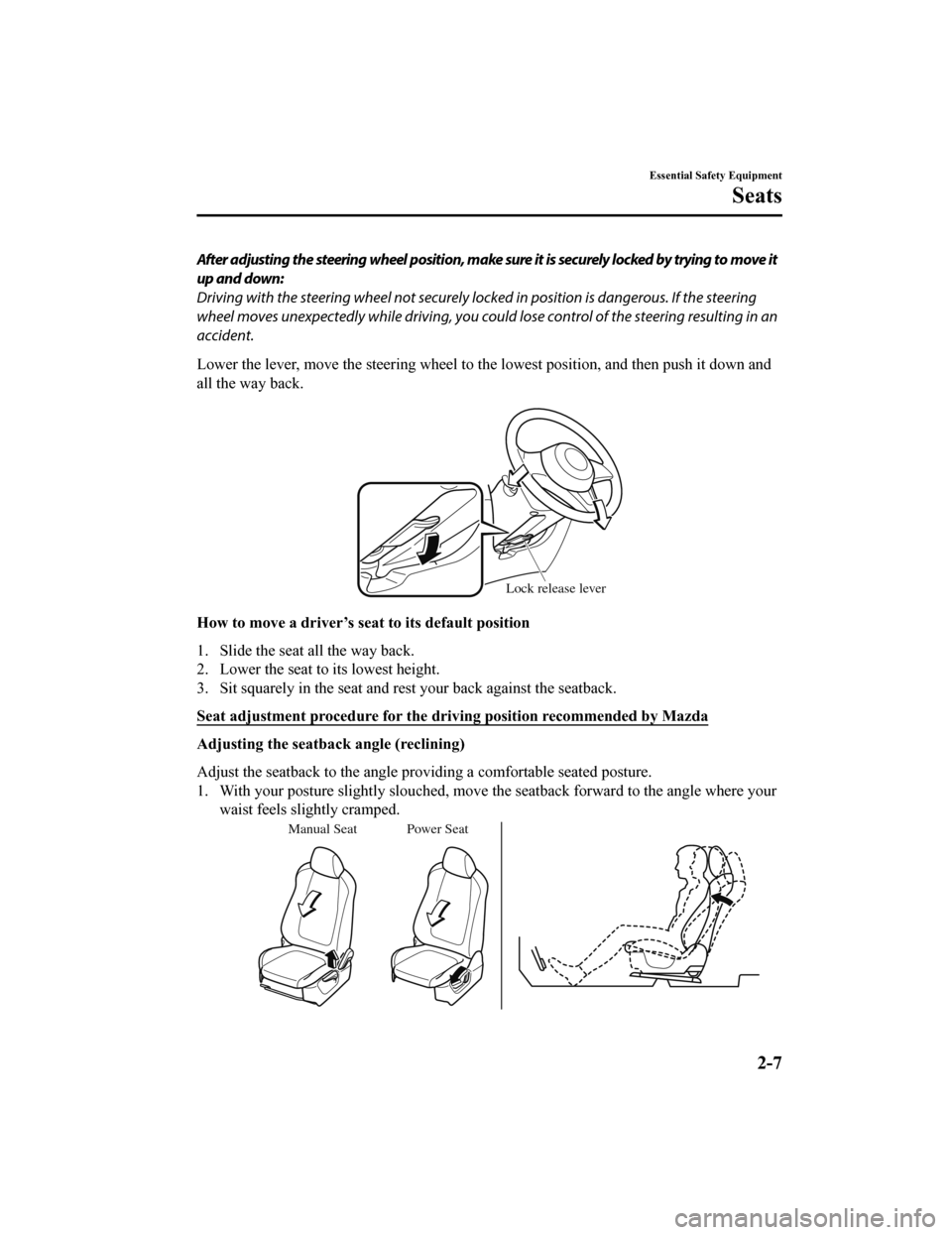
After adjusting the steering wheel position, make sure it is securely locked by trying to move it
up and down:
Driving with the steering wheel not securely locked in position is dangerous. If the steering
wheel moves unexpectedly while driving, you coul d lose control of the steering resulting in an
accident.
Lower the lever, move the steering wheel to th e lowest position, and then push it down and
all the way back.
Lock release lever
How to move a driver’s se at to its default position
1. Slide the seat all the way back.
2. Lower the seat to its lowest height.
3. Sit squarely in the seat and rest your back against the seatback.
Seat adjustment procedure for the driving position recommended by Mazda
Adjusting the seatba ck angle (reclining)
Adjust the seatback to the angle providing a comfortable seated posture.
1. With your posture slightly slouched, move the seatback forward to the angle where your waist feels slightly cramped.
Manual Seat Power Seat
Essential Safety Equipment
Seats
2-7
CX-9_8HT8-EA-19I_Edition2_old 2019-9-24 13:14:55
Page 22 of 706
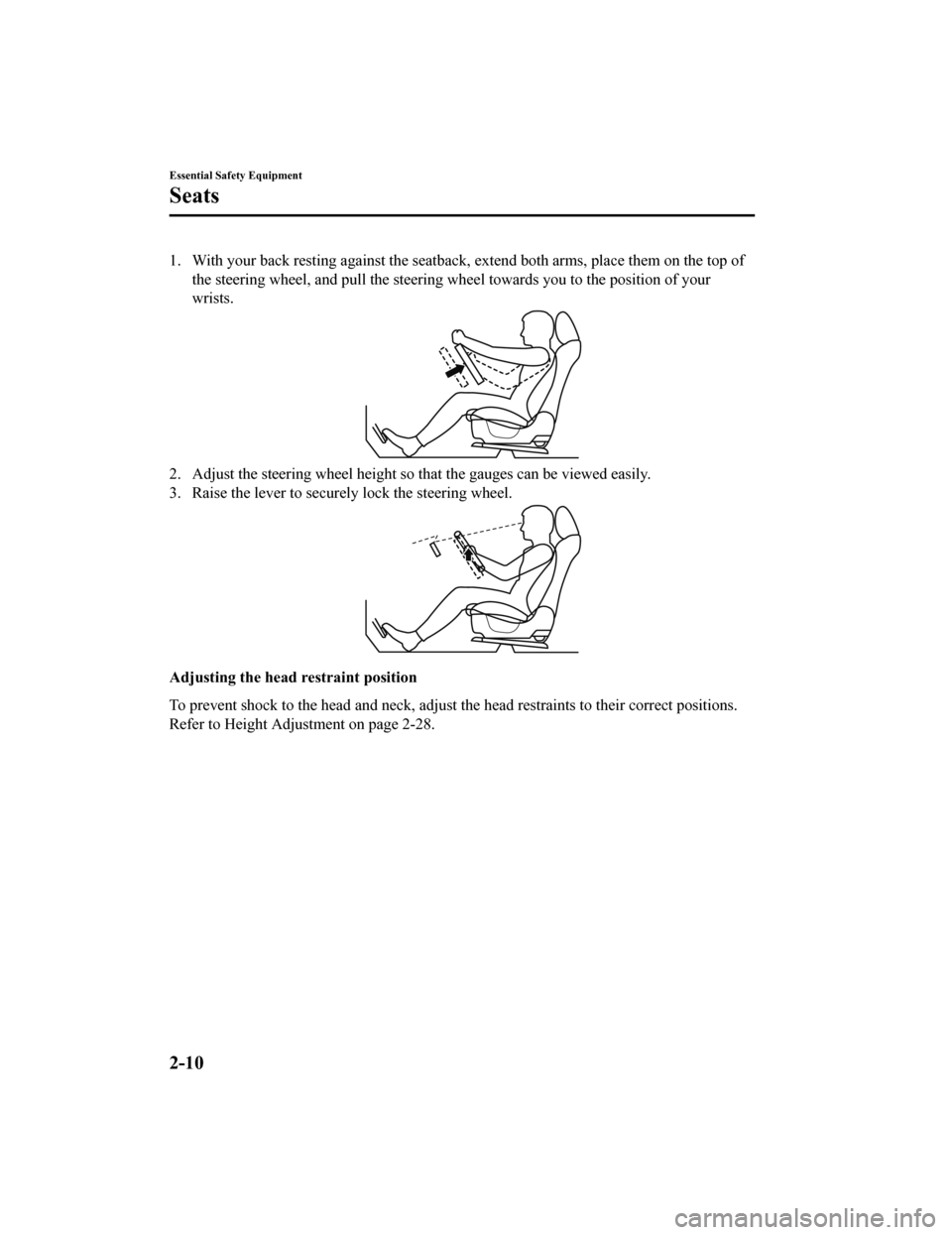
1. With your back resting against the seatback, extend both arms, place them on the top of
the steering wheel, and pull the steering wh eel towards you to the position of your
wrists.
2. Adjust the steering wheel height so that the gauges can be viewed easily.
3. Raise the lever to secure ly lock the steering wheel.
Adjusting the head restraint position
To prevent shock to the head and neck, adjust the head restraints to their correct positions.
Refer to Height Adjustment on page 2-28.
Essential Safety Equipment
Seats
2-10
CX-9_8HT8-EA-19I_Edition2_old 2019-9-24 13:14:55
Page 23 of 706
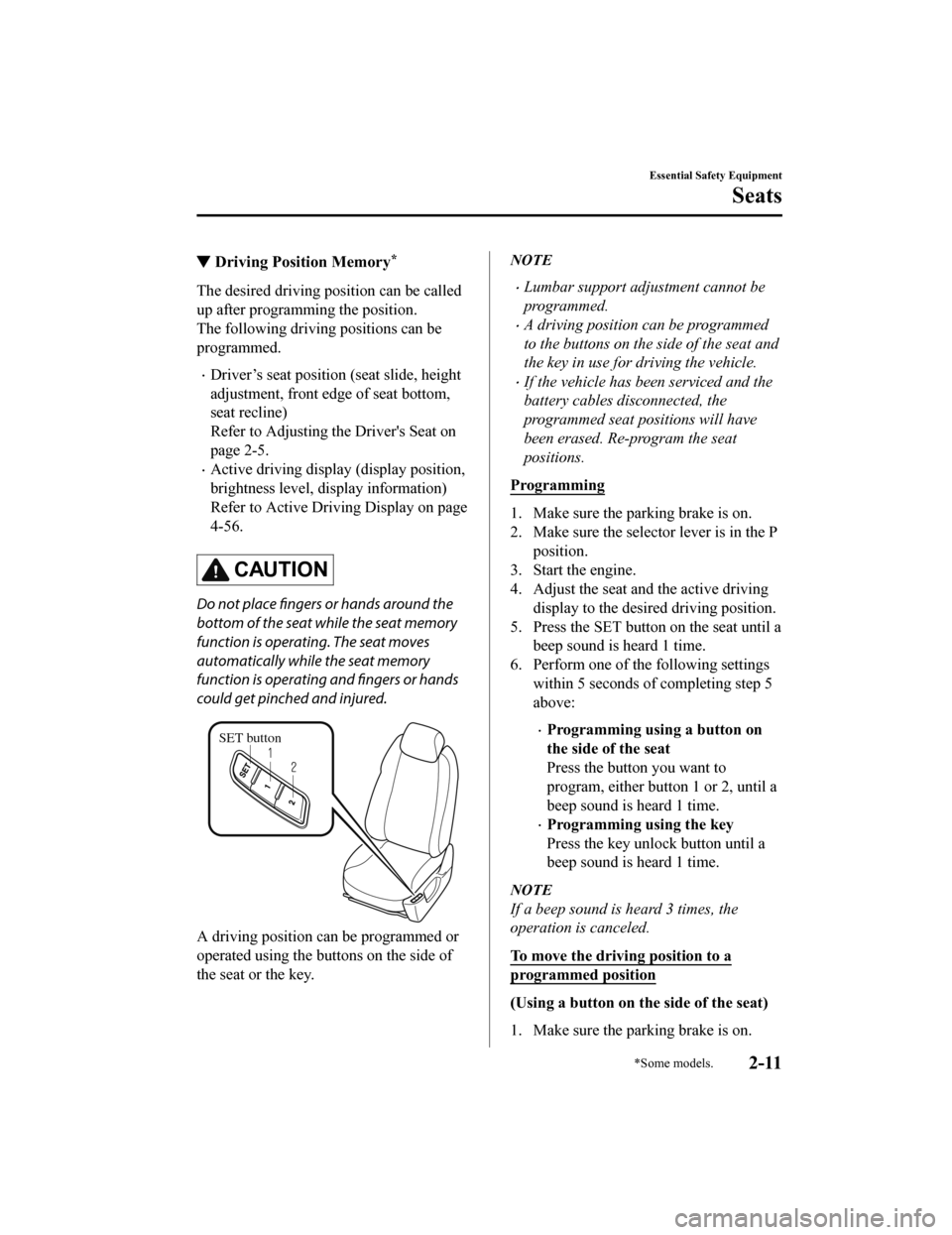
▼Driving Position Memory*
The desired driving position can be called
up after programming the position.
The following driving positions can be
programmed.
Driver’s seat position (seat slide, height
adjustment, front edge of seat bottom,
seat recline)
Refer to Adjusting the Driver's Seat on
page 2-5.
Active driving display (display position,
brightness level, display information)
Refer to Active Driving Display on page
4-56.
CAUTION
Do not place fingers or hands around the
bottom of the seat while the seat memory
function is operatin
g. The seat moves
automatically while the seat memory
function is operating and fingers or hands
could get pinched and injured.
SET button
A driving position can be programmed or
operated using the buttons on the side of
the seat or the key.
NOTE
Lumbar support adjustment cannot be
programmed.
A driving position can be programmed
to the buttons on the side of the seat and
the key in use for driving the vehicle.
If the vehicle has been serviced and the
battery cables disconnected, the
programmed seat positions will have
been erased. Re-program the seat
positions.
Programming
1. Make sure the parking brake is on.
2. Make sure the selector lever is in the P position.
3. Start the engine.
4. Adjust the seat and the active driving display to the desired driving position.
5. Press the SET button on the seat until a beep sound is heard 1 time.
6. Perform one of the following settings within 5 seconds of completing step 5
above:
Programming using a button on
the side of the seat
Press the button you want to
program, either button 1 or 2, until a
beep sound is heard 1 time.
Programming using the key
Press the key unlock button until a
beep sound is heard 1 time.
NOTE
If a beep sound is heard 3 times, the
operation is canceled.
To move the driving position to a
programmed position
(Using a button on the side of the seat)
1. Make sure the parking brake is on.
Essential Safety Equipment
Seats
*Some models.2-11
CX-9_8HT8-EA-19I_Edition2_old 2019-9-24 13:14:55
Page 25 of 706
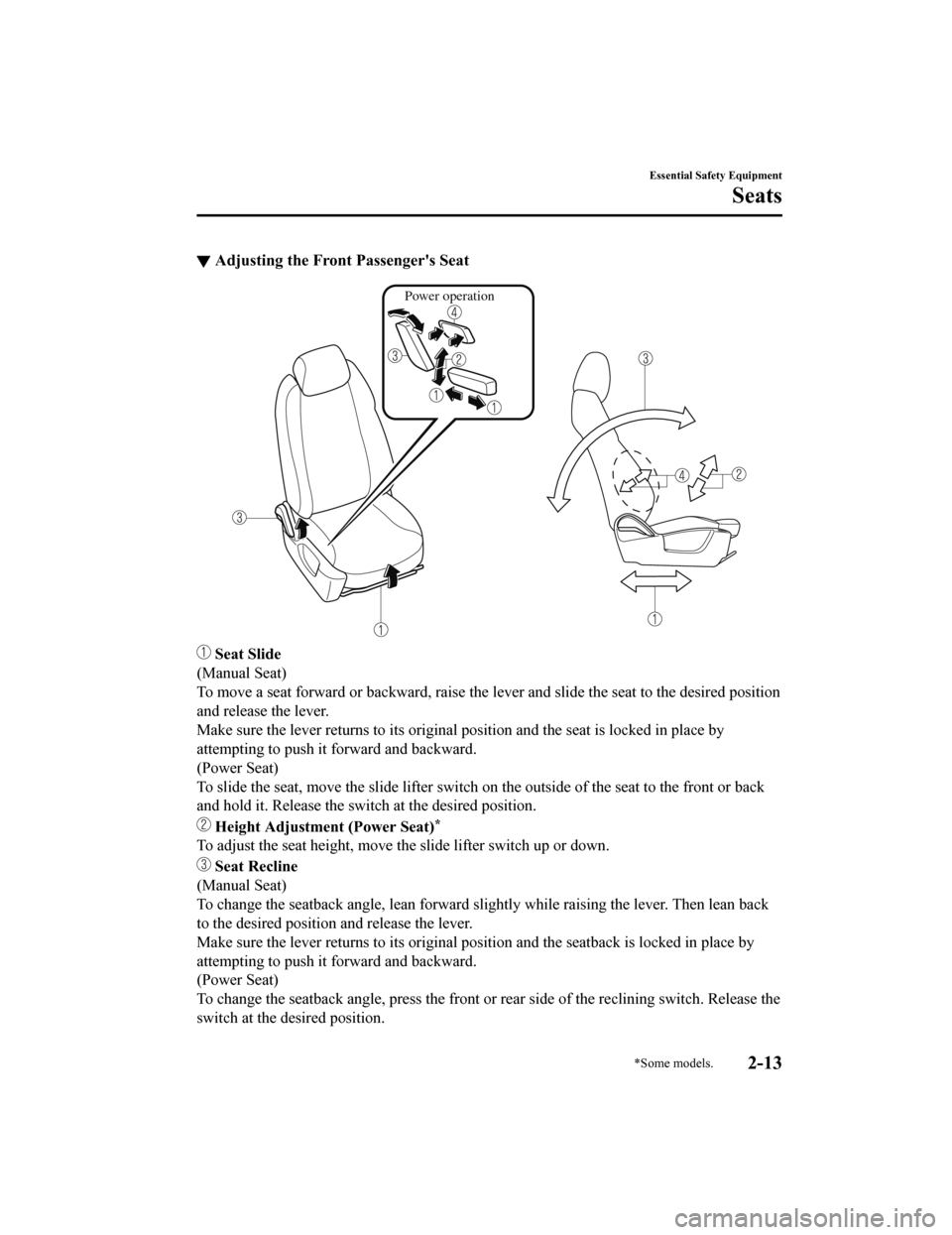
▼Adjusting the Front Passenger's Seat
Power operation
Seat Slide
(Manual Seat)
To move a seat forward or backward, raise the lever and slide the seat to the desired position
and release the lever.
Make sure the lever returns to its original position and the seat is locked in place by
attempting to push it forward and backward.
(Power Seat)
To slide the seat, move the slide lifter switch on the outside of the seat to the front or back
and hold it. Release the sw itch at the desired position.
Height Adjustment (Power Seat)*
To adjust the seat height, move th e slide lifter switch up or down.
Seat Recline
(Manual Seat)
To change the seatback angle, lean forward slightly while raising the lever. Then lean back
to the desired position and release the lever.
Make sure the lever returns to its original pos ition and the seatback is locked in place by
attempting to push it forward and backward.
(Power Seat)
To change the seatback angle, press the front or rear side of the reclining switch. Release the
switch at the desired position.
Essential Safety Equipment
Seats
*Some models.2-13
CX-9_8HT8-EA-19I_Edition2_old 2019-9-24 13:14:55
Page 40 of 706
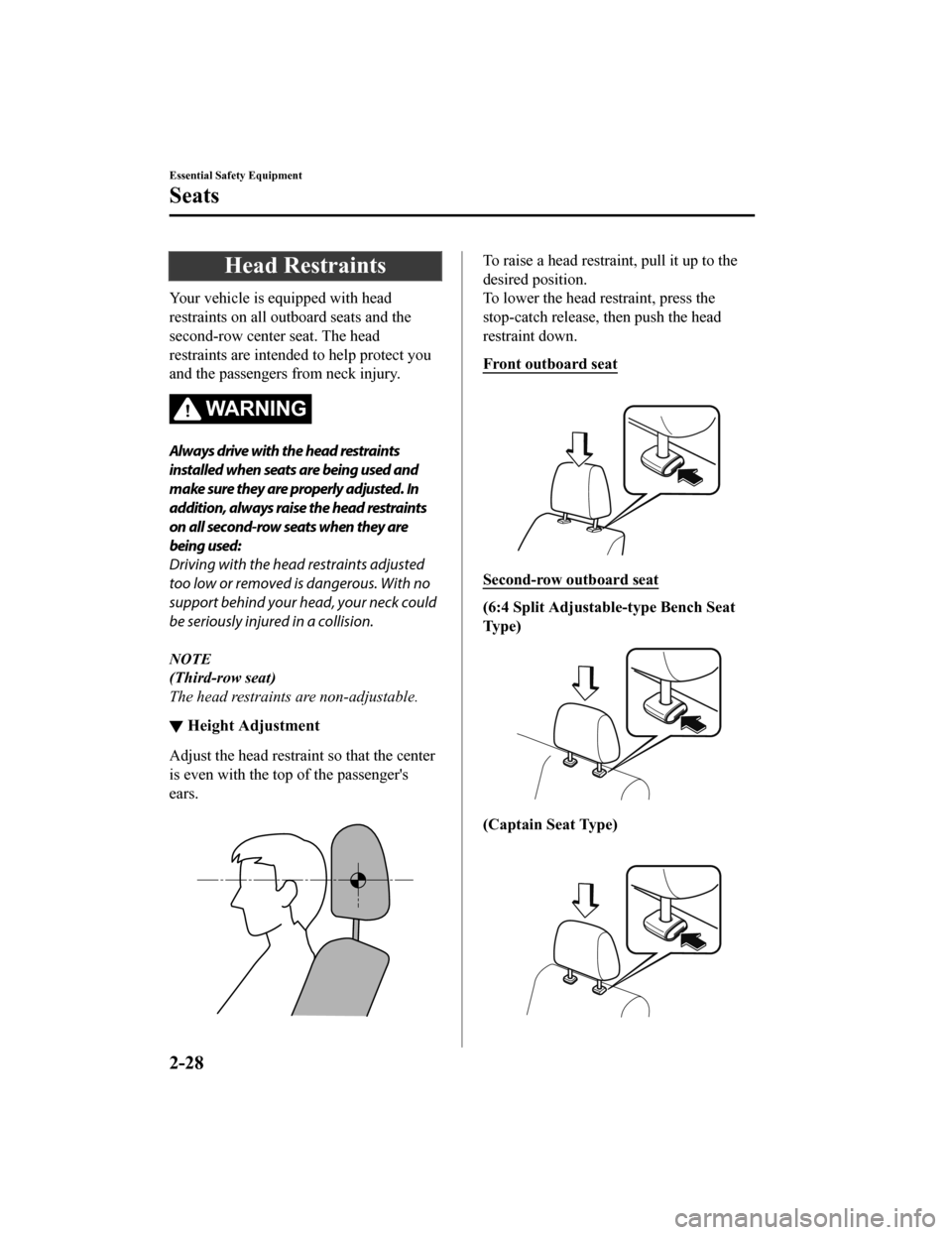
Head Restraints
Your vehicle is equipped with head
restraints on all outboard seats and the
second-row center seat. The head
restraints are intended to help protect you
and the passengers from neck injury.
WA R N I N G
Always drive with the head restraints
installed when seats are being used and
make sure they are properly adjusted. In
addition, always raise the head restraints
on all second-row seats when they are
being used:
Driving with the head restraints adjusted
too low or removed is dangerous. With no
support behind your head, your neck could
be seriously injured in a collision.
NOTE
(Third-row seat)
The head restraints are non-adjustable.
▼Height Adjustment
Adjust the head restraint so that the center
is even with the top of the passenger's
ears.
To raise a head restraint, pull it up to the
desired position.
To lower the head restraint, press the
stop-catch release, then push the head
restraint down.
Front outboard seat
Second-row outboard seat
(6:4 Split Adjustable-type Bench Seat
Ty p e )
(Captain Seat Type)
Essential Safety Equipment
Seats
2-28
CX-9_8HT8-EA-19I_Edition2_old
2019-9-24 13:14:55
Page 63 of 706
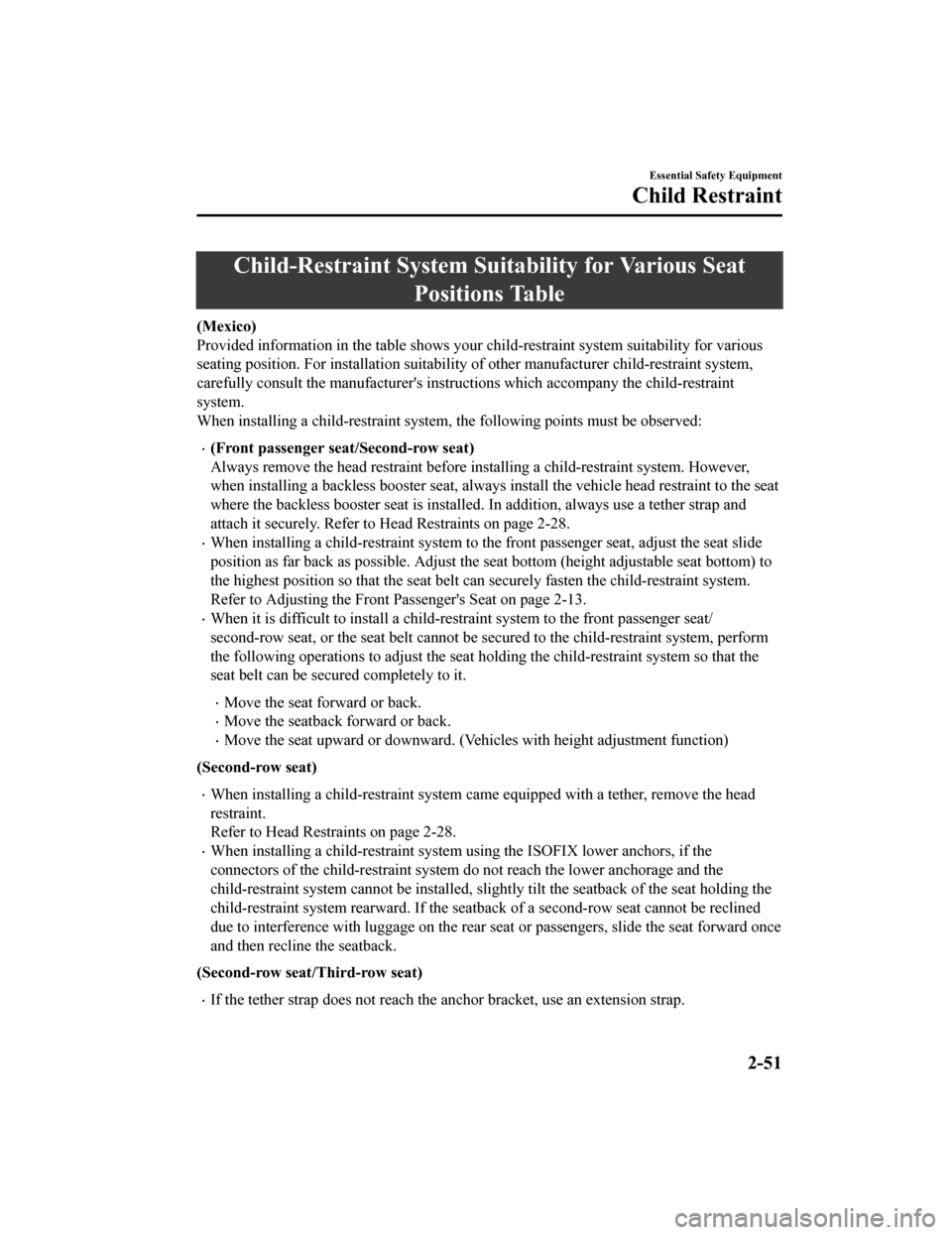
Child-Restraint System Suitability for Various SeatPositions Table
(Mexico)
Provided information in the table shows your child-restraint system suitability for various
seating position. For installati on suitability of other manufact urer child-restraint system,
carefully consult the manufacturer's instructions which accompany the child-restraint
system.
When installing a child-restraint system , the following points must be observed:
(Front passenger seat/Second-row seat)
Always remove the head restraint before installing a child-restraint system. However,
when installing a backless booster seat, always install the vehicle head restraint to the seat
where the backless booster seat is installed. In addition, always use a tether strap and
attach it securely. Refer to He ad Restraints on page 2-28.
When installing a child-restraint system to the front passenger seat, adjust the seat slide
position as far back as possible. Adjust the seat bottom (height adjustable seat bottom) to
the highest position so that the seat belt can securely fasten the child-restraint system.
Refer to Adjusting the Front Passenger's Seat on page 2-13.
When it is difficult to install a child-restraint system to the front passenger seat/
second-row seat, or the seat belt cannot be se cured to the child-restraint system, perform
the following operations to adju st the seat holding the child-restraint system so that the
seat belt can be secured completely to it.
Move the seat forward or back.
Move the seatback forward or back.
Move the seat upward or downward. (Vehicles with height adjustment function)
(Second-row seat)
When installing a child-restraint system came equipped with a tether, remove the head
restraint.
Refer to Head Restraints on page 2-28.
When installing a child-restraint system using the ISOFIX lower anchors, if the
connectors of the child-restraint system do not reach the lower anchorage and the
child-restraint system cannot be installed, slightly tilt the seatback of the seat holding the
child-restraint system rearward . If the seatback of a second-row seat cannot be reclined
due to interference with luggage on the rear seat or passengers, slide the seat forward once
and then recline the seatback.
(Second-row seat/Third-row seat)
If the tether strap does not reach the anchor bracket, use an extension strap.
Essential Safety Equipment
Child Restraint
2-51
CX-9_8HT8-EA-19I_Edition2_old 2019-9-24 13:14:55
Page 160 of 706
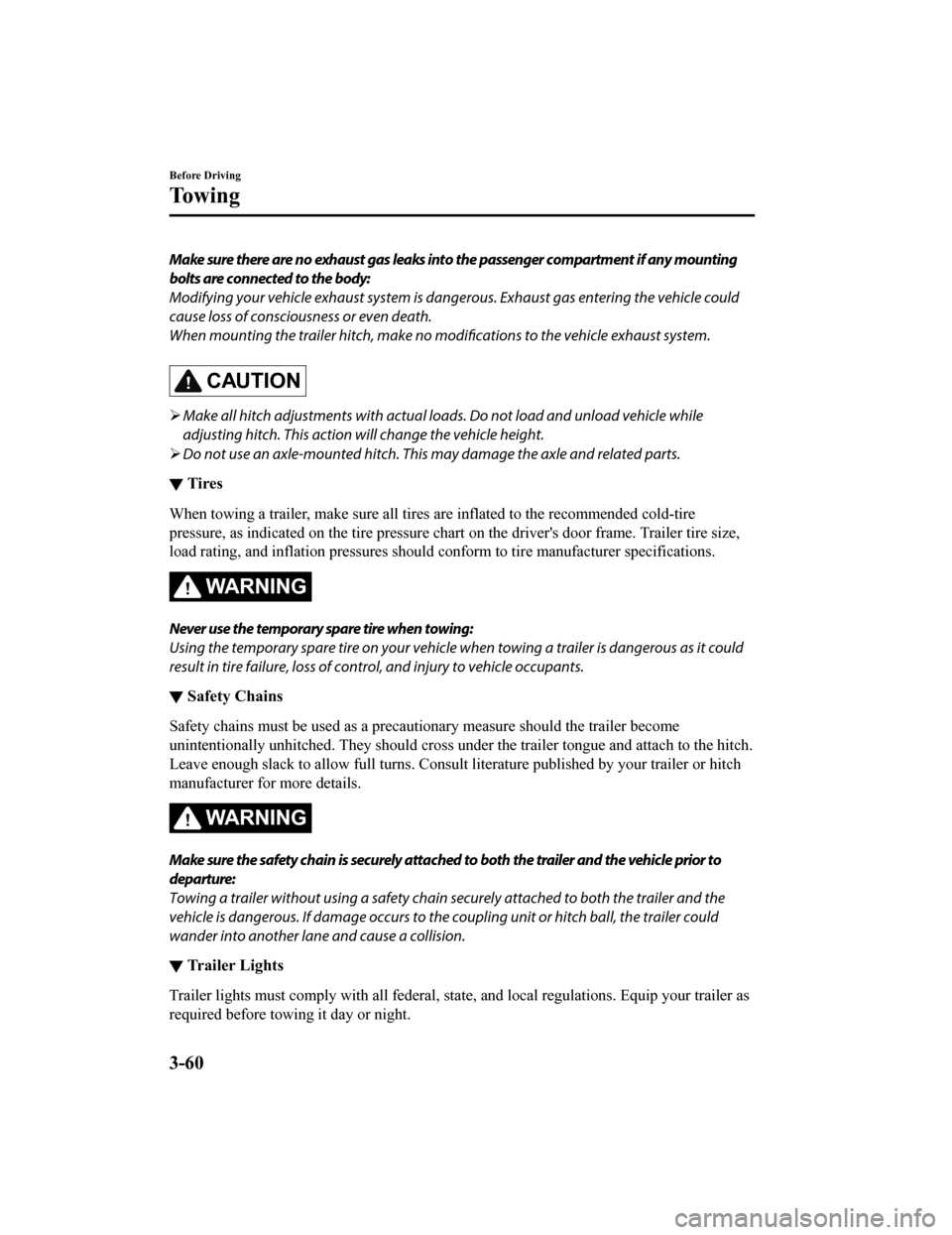
Make sure there are no exhaust gas leaks into the passenger compartment if any mounting
bolts are connected to the body:
Modifying your vehicle exhaust system is dangerous. Exhaust gas entering the vehicle could
cause loss of consciousness or even death.
When mounting the trailer hitch, make no modifications to the vehicle exhaust system.
CAUTION
Make all hitch adjustments with actual loads. Do not load and unload vehicle while
adjusting hitch. This action wi ll change the vehicle height.
Do not use an axle-mounted hitch. This may damage the axle and related parts.
▼ Tires
When towing a trailer, make sure all tires
are inflated to the recommended cold-tire
pressure, as indicated on the tire pressure chart on the driver's door frame. Trailer tire size,
load rating, and inflation pr essures should conform to ti re manufacturer specifications.
WA R N I N G
Never use the temporary spare tire when towing:
Using the temporary spare tire on your vehicle wh en towing a trailer is dangerous as it could
result in tire failure, loss of control, and injury to vehicle occupants.
▼ Safety Chains
Safety chains must be used as a precautionary measure should the trailer become
unintentionally unhitched. They should cross un
der the trailer tongue and attach to the hitch.
Leave enough slack to allow full turns. Consult literature published by your trailer or hitch
manufacturer for more details.
WA R N I N G
Make sure the safety chain is securely attached to both the trailer and the vehicle prior to
departure:
Towing a trailer without using a safety chain securely attached to both the trailer and the
vehicle is dangerous. If damage occurs to the coupling unit or hitch ball, the trailer could
wander into another lane and cause a collision.
▼ Trailer Lights
Trailer lights must comply with all federal, st
ate, and local regulations. Equip your trailer as
required before towing it day or night.
Before Driving
To w i n g
3-60
CX-9_8HT8-EA-19I_Edition2_old 2019-9-24 13:14:55
Page 223 of 706

Refer to Blind Spot Monitoring (BSM) on page 4-121.
Distance Recognition Support System (DRSS) Operation Conditions and Warnings
Refer to Distance Recognition Support System (DRSS) on page 4-133.
Traffic Sign Recognition System (TSR) traffic signs and Warnings
Refer to Traffic Sign Recognition System (TSR) on page 4-127.
Mazda Radar Cruise Control wi th Stop & Go function (MRCC with Stop & Go function)
Operation Conditions and Warnings
Refer to Mazda Radar Cruise Control with Stop & Go function (MRCC with Stop & Go
function) on page 4-141.
Lane-keep Assist System (LAS) & Lane De parture Warning System (LDWS) Operation
Conditions and Warnings
Refer to Lane-keep Assist System (LAS) & Lane Departure Warning System (LDWS) on
page 4-156.
Advanced Smart City Brake Support (Advanced SCBS) Warnings
Refer to Advanced Smart City Brake Support (Advanced SCBS) on page 4-167.
Smart City Brake Support (SCBS) Warnings
Refer to Smart City Brake Support (SCBS) on page 4-170.
Smart Brake Support (SBS) Warnings
Refer to Smart Brake Support (SBS) on page 4-173.
Cruise Control Operation Conditions
Refer to Cruise Control on page 4-212.
Navigation Guidance (vehicles with navigation system)
Speed limit indicator (vehicles with navigation system)
Vehicle Speed
Each setting/adjustment for the active driving display can be performed on the center
display.
1. Select the
icon on the home screen and display the Settings screen.
2. Select the AD-Disp tab.
3. Select the desired item and perform the setting/adjustment.
Method for adjusting screen br ightness (automatically/manually)
Screen brightness initial settings (automatic adjustment is selected)
Screen brightness adjustment (manual adjustment is selected)
Display position of active driving display (display height)
Active driving display angle adju stment (display angle correction)
Active driving display ON/OFF (indication)
Navigation guidance ON/OFF
When Driving
Instrument Cluster and Display
4-57
CX-9_8HT8-EA-19I_Edition2_old 2019-9-24 13:14:55